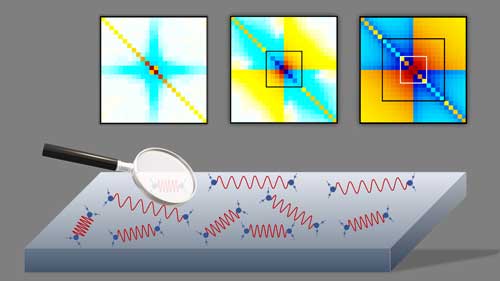| Feb 22, 2021 |
CSI Solid-State: The fingerprints of quantum effects
(Nanowerk News) In solid-state physics the precise interactions of electrons are analyzed in meticulous detective work to ultimately gain a better understanding of fundamental physical phenomena.
It comes as no surprise to fans of the thriller genre that in order to solve a case, fingerprints must be carefully searched for at the crime scene.
|
|
In modern-day solid-state physics, it is scattering processes - interactions between electrons - that hold the clues necessary for getting closer to the truth.
|
|
Revealing the crucial “hints” is particularly difficult in the case of complex materials where many electrons play a role simultaneously: In so-called “many-electron systems”, trillions of electrons can be connected to one another and exchange energy and momentum.
|
|
At the Vienna University of Technology, the University of Tübingen and the École Polytechnique in Paris, important progress has now been made: With the help of a precise analysis, new structures could be identified, the so-called “fingerprints” - characteristic patterns in the complicated scattering processes - which should help to clear the “case”.
|
 |
| The three colorful panels illustrate the scattering processes. The black and white squares mark the important characteristic structures identified and described in the PRL paper. (Image: Patrick Chalupa)
|
Scattering processes and material properties
|
|
Among other properties, scattering processes determine the mobility of the charge carriers and thus control whether the system ultimately exhibits a metallic, insulating or even superconducting behavior. Simply put, these mathematical quantities reflect how strong the electrons “feel” each other.
|
|
With the help of extensive computer simulations, condensed matter researchers attempt to nail down the physical properties of the many-electron systems, and ultimately answer fundamental questions of solid-state physics, for example: “How do unconventional superconductors work” or “How do quantum physical phase transitions take place at absolute zero”?
|
|
An international research team, including the group of Professor Alessandro Toschi (Patrick Chalupa, Matthias Reitner und Daniel Springer) from the TU Wien, Professor Sabine Andergassen from the University of Tübingen and Thomas Schäfer (now head of research group at the Max Planck Institute in Stuttgart) from the École Polytechnique in Paris, has achieved important progress in this respect. An in-depth analysis of the scattering processes and their comparison in different physical situations allowed for the identification of clear-cut “fingerprints”.
|
|
The results of the study were published in the journal Physical Review Letters ("Fingerprints of the local moment formation and its Kondo screening in the generalized susceptibilities of many-electron problems" DOI:10.1103/PhysRevLett.126.056403).
|
New connections uncovered
|
|
Similar to forensic scientists at a crime scene, the researchers tried to connect many small details to see the bigger picture. They succeeded in identifying characteristic structures in the complex mathematical quantities that describe the scattering processes and to relate these structures to two fundamental phenomena of solid-state physics.
|
|
These fundamental phenomena turned out to be the formation of local magnetic moments as well as their screening due to the so-called Kondo effect, which both crucially control the mobility of electrons. This new connection allows for recognizing the relevant physical effects in the complex scattering processes in just a single glance.
|
|
By identifying these “fingerprints” it was even possible to discover an alternative criterion for determining one of the most fundamental energy scales in theoretical solid-state physics: the Kondo temperature.
|
|
Eventually, these findings could shed new light on for decades unsolved “thrillers” in solid-state physics, for example, quantum criticality in heavy fermion systems, unconventional superconductivity in strongly correlated quantum materials and surprising magnetic phenomena in transition metal oxides. The correct determination of the underlying quantum fingerprints could put research on the right track to understand these systems at a fundamental level.
|

